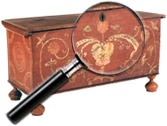Stanhopes
The Stanhope viewer combines a miniature microphotographic lens and photograph hidden in a mid-nineteenth century novelty item.
The Stanhope takes its name from the inventor of its lens, Charles the 3rd Earl of Stanhope (1753 to 1816). He first developed a basic handheld viewer with two lens of unequal curvature. The design would later be modified to use one curved magnifying lens and one flat lens, although Stanhope himself died long before this advance was made and before the lens were incorporated into the novelty viewers.
A British scientist and inventor, John Benjamin Dancer (1812 to 1887) of Manchester, invented Microphotography in 1839. But it was not until 1852 that he used the wet plate collodion process to produce a microphotograph on collodion film, which was in turn mounted onto a microscope slide. The chief drawback was that you required a microscope to view the image. As one can imagine, these were not readily available to the general public.
The microphotographic lens that would play a crucial part in the production of the viewers came from Frenchman Rene Prudent Patrice Dagron (1819 to 1900). He used the Stanhope lens and a microphotograph in combination to form a single lens and photograph, and he patented this invention in 1859. He then placed what he referred to as the “cylinders photomicroscopiques” into a range of novelty items.
Dagron became so successful that he opened a mail order business and factory to meet the demand for his invention. His factory was based in Gex in France. Although under new ownership from 1900, production continued until 1972 when the last Stanhope lenses were produced.
The lens itself is not much larger than a pinhead but when viewed shows the subject with tremendous clarity. The subject matter ranges from famous people to topographical locations. These items were brought by tourists as souvenirs, and were simply viewed by holding them up to a strong light source.
Stanhopes can be found in a multitude of items the most common of which are sewing accessories including needle cases, thimbles and pincushions. The less common items include penholders, letter openers, pipes, vesta (match) cases, jewelry, whistles and perfume bottles.
These tiny items are often overlooked but are highly collectible. The price is more affected by the scarcity of the object holding the image rather than the image itself. Condition as usual also affects the price. Prices range from $20 to several hundred dollars for scarce examples.
reference note by p4A contributing editor Robert Ginns.
